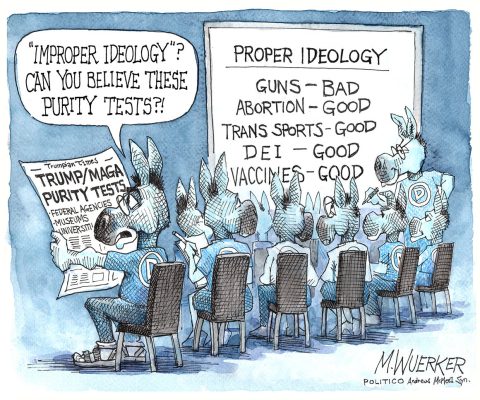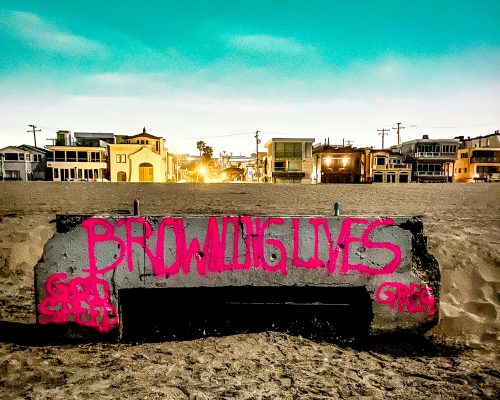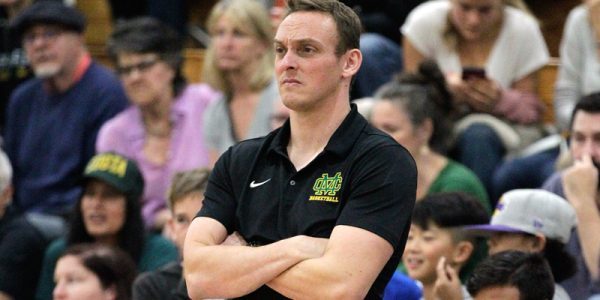
Tuesday night, hundreds of people streamed into the Redondo Beach Performing Arts Center to sit before a six-person panel assembled at a table onstage.
The six sit on a committee of the California Energy Commission (CEC) – the state body which will approve or reject energy company AES’ application to re-power its Harbor Drive plant – and they had come from Sacramento to preside over the first in a series of local, public meetings to keep residents abreast of the Commission’s decision-making process.
Throughout the evening, the committee’s lead commissioner, Karen Douglas, would repeat some form of this reminder: “We are at the very early stage of the process. No decisions are being made tonight.” Upon opening the meeting, she made it clear that the committee would not permit “applause contests” and uncivil behavior.
“These proceedings can be long and they can be contentious and they can be emotionally draining at times,” Douglas said into a microphone. “This is a community and we’re all part of this community.”
In the audience were most of the usual players, those who have been following the power plant issue for months, or even years. A City Council meeting scheduled for Tuesday evening had been cancelled so that council members, city staff, and engaged citizens could attend the CEC hearing. AES management was there, as were representatives of other state agencies that will play a role in the possible licensing and permitting of the power plant.
But there was another group of people present, too – unionized tradespeople, distinguishable by the hard hats and overalls they wore that symbolized their reason for being there. They were fighting for the jobs a new power plant might create; their shirts were pinned with “Yes AES” buttons.
“I thought I would see a bunch of my neighbors here tonight,” resident James McLeod remarked during the public comment period. “Instead, I saw a bunch of funny little hard hats.”
The auditorium tuned in for AES Southland President Jennifer Didlo’s description of the project her company is proposing to build.
AES wants to replace its existing 50-acre plant with an updated, 13-acre facility reliant on more modern technology that complies with new state regulations.
Didlo noted that the new plant will take significantly less time to begin operating; currently it takes 12 to 36 hours to rev up, a lag that would render unusable a renewable resource like sun or wind. She said the new plant will “look more like an office building” than a power plant, and will ensure power reliability for Redondo Beach and its surrounding areas.
“If you have a fire station in your community and you need to call on that fire station, they’re certainly going to be able to get to your house much faster than if they’re three communities away,” Didlo said. “The closer the power plant is to you, the more reliable your electricity is, because it relies on less transmission.”

Stephen O’Kane, AES’ manager of sustainability and regulatory compliance, added that the new plant will be “60 percent smaller and 50 percent more efficient,” and drastically shrinking the size of the plant will be akin to “removing an entire plant from the South Bay.” The project will be a $500 million private investment, and if approved, constructed between January 2016 and December 2020.
Next, Douglas reviewed the complicated, lengthy, and protocol-bound process by which the CEC reaches a decision. There are three phases. The first, during which staff reviews AES’ application to determine whether it contains enough information, drew to a close in August when the CEC declared the submitted document “data adequate.”
That led into the “discovery and analysis” stage – a time for public workshops, environmental reviews, and analysis of possible alternatives to the project – that is currently underway. The final stretch comprises evidentiary hearings and a final decision, likely to be more than a year from now.
Upon concluding her brief, Douglas opened the floor. More than 50 people had submitted blue cards indicating their desire to speak; the public comment period would exceed two hours.
First up were elected officials. Assemblymember Steve Bradford of Gardena expressed concern that if AES leaves Redondo Beach, it will enter another, less affluent community.
“And that shouldn’t be the case,” he said. “This facility has existed [here] well over 100 years.”
Assemblymember Travis Allen of Huntington Beach vouched for AES, saying “AES has done exactly what the state has asked them to do” and called the company “a great player” in his constituency.
Five Redondo Beach council members joined together in their plea for the CEC to conduct a “needs analysis,” or a study to determine whether retiring the Redondo Beach plant will in fact deprive the West Los Angeles Basin of reliable power or whether the grid can obtain its supply elsewhere.
“Since about the year 2000 or so, we’ve been trying to work with AES on getting them to vacate the premises,” Mayor Steve Aspel said. “It hasn’t worked out for one reason or another and now there’s an opportunity for AES to gracefully go away if it’s deemed that the power is not necessary.”
He continued: “If the Commission and state of California deem the power necessary, then for better or for worse the citizens will live with it. But we want to make sure there’s a needs analysis and you deem the power vital to the grid.”
During the comment period for the general public, resident Ken Perry delivered an eloquent argument for conducting a needs analysis, prompting applause from other citizens of Redondo Beach.
“It reminds me of [the idiom] ‘Build a better mousetrap and the world will beat a path to your door,’” Perry said. “That may be true if you have a mouse problem, but it seems to me nobody has determined if we’ve got a mouse problem.
“‘Let’s build a plant and then we’ll think about maybe needing the energy.’ It just seems, from a layperson’s point of view, completely backwards.
“How can you make an informed decision about the plant? Because we know that even if it’s smaller, small doesn’t mean zero. It’s going to have a negative impact on the environment. It’s just a matter of magnitude. If you don’t determine if we need the energy, why would we want to degrade the environment? I just don’t get that. If you don’t base your decision on need, what do you base it on?”
As for the proposed project, he said: “That is absolutely a better mousetrap, but from what I’m hearing… we don’t have a mouse problem.”
Perry’s fellow residents were divided in their positions on the issue.
On behalf of the Redondo Beach Chamber of Commerce, chief executive officer Marna Smeltzer voiced support for the project. Resident Mike Koblosh was also supportive, noting concerns about power reliability.
“Putting [a plant] in somebody else’s backyard and hoping for them to pump [power] to us later when we need it is not a good idea,” he said.
“AES has been a good neighbor,” Joan Irvine said. “They’ve been around here a lot longer than I know I have.”
Rob Gaddis disagreed.
“Frankly, AES has not been a good neighbor to us in Redondo Beach,” he said. “They spend a lot of money interfering with our local elections [and] promoting their own agenda… so we’re looking forward to getting rid of them.”
Members of the Los Angeles County Business Federation and United Association Local 250 – a union of steamfitters and piping industry employees – spoke in strong support of the project.
“I believe that this is a no-brainer,” said George Vasquez, who works on steam plants and said he was “impressed with what AES presented.”
Dozens of union members spoke passionately about the jobs a new power plant will create: 149 construction workers during construction and 338 during peak hours, plus 21 operational employees to maintain the plant, according to AES’ application.

“We already pay the highest gas prices,” resident Joe Lenihan said. “We pay some of the highest food prices and we want to ship all our jobs to other states. This is an exciting opportunity for us to take an existing plant, reduce it [and] save some of our infrastructure and utilize the area around it to improve our community with jobs, local jobs, construction jobs and long-term jobs.”
But some residents were decidedly suspect of those arguing in favor of job creation.
“Kudos to AES for the visuals with the hard hats,” resident Kay Gagnon said. “It definitely tugs on my heartstrings… I respect all workers being represented tonight but the gravity of this decision really demands focus on facts… and the greater good, not our heartstrings.”
“The creation of jobs [argument] is a joke,” Delia Vechi said later. “Because jobs will be here in construction but after that… there will be only 21 permanent people working in the plant. That’s not creation of jobs.”
Added Lori Zaremski: “I want to say with all due respect to all of the people with AES buttons and hard hats: We all need employment, but we’re here to talk about the health of your children and their grandchildren and their children, and these jobs aren’t going to be here forever.”
Edward Smith spoke to the committee via web conferencing technology: “I love all the Local 250 guys but… AES is going to pawn that out to the cheapest labor they can possibly find and I doubt it’s local union staff.”
Former congressional candidate Zein Obagi also weighed in: “Of course a new power plant will bring jobs,” he said. “So, too, will the bridge to nowhere in Alaska.”
There were concerns about the impact of a new power plant on public health – clinic psychologist Roger Light called Harbor Dr. an “entirely unsuitable location” – and concerns about the integrity of health and air quality data presented by AES, which O’Kane is “confident” will be corroborated by any state agency that undertakes its own tests and studies.
Jim Light, president of Building a Better Redondo – a non-profit organization that has been fighting this plant for years – charged that AES provides the public with “misleading data” and “deceptive” renderings and “pollution projections that totally ignore photographic evidence we’ve submitted.”
“Consistently, AES has misled us with misrepresentation of emissions numbers and usage numbers… They have taught this community to be distrustful of them. We need better,” Gerry O’Connor later agreed. “Elected officials that support it are not local… I doubt those guys are even still here,” he added, looking around the emptying room.
As for local legislators who unable to be present, three declared public positions in the weeks leading up to the hearing. In a letter addressed to CEC Chair Robert Weisenmiller and dated Sept. 26, Congressman Henry Waxman urged the commission to reject the project unless it is proven that the facility is essential and there are no feasible alternatives. Assemblymember Al Muratsuchi, whose constituencies include Redondo Beach, sent a similar letter to Weisenmiller on Sept. 24.
“Unless the power from the proposed facility is needed, and there are no alternatives to fulfill a determined need for the region, I would oppose the power plant at the current site,” his letter reads. Senator Ted Lieu’s letter to Weisenmiller was more netural, but requests a needs analysis to ensure power is actually required from this particular site to ensure grid reliability, and to thoroughly examine and identify alternatives.”
Following Tuesday’s public comment period, the CEC committee made several logistical announcements. Within two weeks, the Commission will set a preliminary schedule. By Oct. 15, it will make specific requests of AES for data; their deadline for a response is Nov. 15. Another public workshop is tentatively planned for early December in Redondo Beach.
For more information on AES’ proposed project, see www.energy.ca.gov/sitingcases/redondo_beach/. To comment on the proceeding, visit https://efiling.energy.ca.gov/Ecomment/Ecomment.aspx?docketnumber=12-AFC-03.









